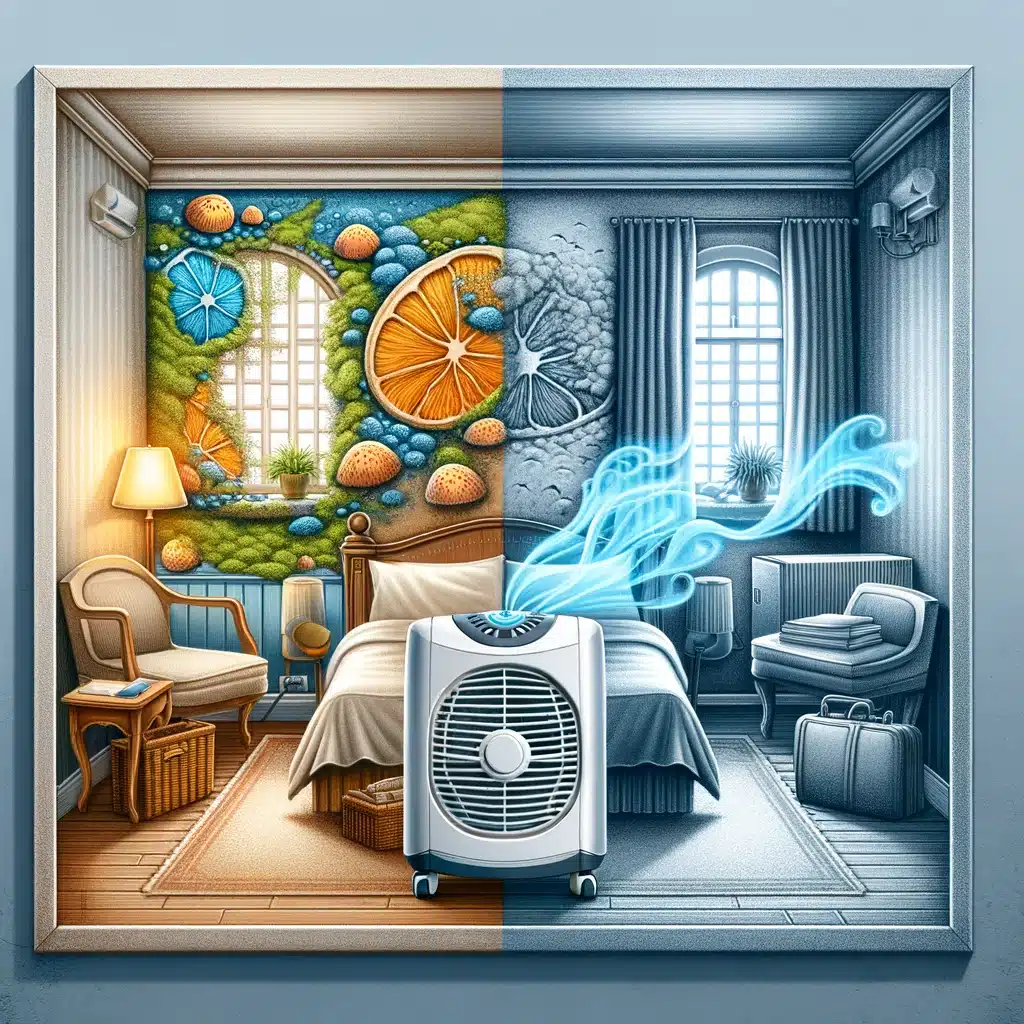Introduction
Going on holiday and staying in rental accommodations can be an exciting adventure. However, uncontrolled humidity levels can quickly turn the experience sour by promoting mold, mildew, dust mites, and bacteria growth. A dehumidifier is an often overlooked but essential appliance for keeping rental spaces dry and comfortable.
In this comprehensive guide, we’ll explore the critical importance of regulating humidity for healthy and enjoyable travels. You’ll learn ideal humidity ranges, how dehumidifiers work, key features to look for, proper usage and maintenance tips, signs you need a dehumidifier, and answers to frequently asked questions.
With the insights from this article, you’ll be able to confidently choose and operate the right dehumidifier to make your next holiday rental stay fresh, clean, and comfortable.
Overview of the Importance of Controlling Humidity Levels While Traveling
Humidity refers to the amount of moisture in the air. All air contains some water vapor, but excessive levels can cause issues. High humidity provides the perfect breeding ground for mold, mildew, bacteria, viruses, dust mites, and other unwanted microbes and allergens.
These organisms thrive in damp conditions and can trigger respiratory issues, allergic reactions, odors, and even structural damage. A dehumidifier removes excess moisture from the air to keep humidity in the ideal 40-50% range for human health and comfort.
Proper humidity control is especially critical in travel lodgings where maintenance and ventilation may be inadequate. Dehumidifiers provide an effective solution to regulate moisture levels and create a clean, comfortable environment.
Brief Explanation of How Dehumidifiers Help Regulate Humidity
Dehumidifiers reduce humidity by drawing moist air over cooled metal coils. The moisture condenses and drips into a tank, while the dry air recirculates back into the room.
Most dehumidifiers have automatic shutoff when the tank is full and a humidistat to maintain the humidity level. Choosing the right size unit and using it properly is key to effectively controlling humidity.
Now let’s look at why humidity control is so important for having an enjoyable holiday.
Why Controlling Humidity is Crucial for Comfortable Travels
Humans feel most comfortable when indoor relative humidity levels are kept between 40-50%. Exposure to very damp or very dry air can cause health issues and discomfort. Here are the main benefits of using a dehumidifier to regulate humidity in your travel lodgings:
Preventing Mold Growth
Mold thrives in damp environments above 55% relative humidity. Excessive mold can cause allergy symptoms, trigger asthma attacks, and may even lead to serious respiratory infections. Mold also causes unpleasant musty odors.
Dehumidifiers maintain humidity below 50% to inhibit mold growth, keeping the space clean and breathable. This is especially critical in humid climates or during rainy seasons.
Minimizing Dust Mites and Other Allergens
Dust mites, pet dander, pollen, and other allergens proliferate in humid, moist air. Controlling humidity below 50% helps decrease allergen levels and reduces exposure.
For people with allergies or asthma, using a dehumidifier can prevent aggravating symptoms and allow more comfortable sleep. Lower humidity also makes regular cleaning more effective at removing allergens.
Avoiding Musty Odors
Ever walked into a damp, musty-smelling room? This unpleasant odor is caused by mold and mildew growth. Dehumidifiers maintain lower humidity levels that prevent mold overgrowth, inhibiting the production of smelly compounds.

This keeps your travel accommodations smelling fresh. You won’t have to contend with the stale, unpleasant odors that high humidity encourages.
Maintaining Ideal Room Temperature
Humidity affects how warm or cool a room feels. The same room at 70°F will feel cooler at 40% humidity than at 80% humidity. This is because higher moisture levels interfere with the evaporation of sweat off your skin.
Dehumidifiers can make a room feel 3-4 degrees warmer at the same air temperature by removing excess moisture. This allows HVAC systems to be set at more energy-efficient temperatures to save on bills.
Preventing Condensation and Water Damage
When humid air contacts colder surfaces like windows and walls, the moisture condenses into water droplets. Over time, condensation can lead to structural damage, encourage mold growth, leave stains, and deteriorate belongings.
Keeping humidity below 50% inhibits condensation from forming in the first place. Dehumidifiers also help basement spaces and other damp areas stay drier and prevent moisture issues.
Health Dangers of High Humidity in Travel Accommodations
Indoor air quality is important for health, especially when you spend extended time inside while traveling. Here are some of the most concerning health hazards that can arise from excessive humidity in rental spaces:
Respiratory Issues From Mold and Mildew
Inhaling airborne mold spores and mycotoxins can cause allergy symptoms, trigger asthma attacks, and may lead to serious infections if immune defenses are compromised. Children, the elderly, and those with chronic lung diseases are most vulnerable.
Using a dehumidifier to control moisture below 50% inhibits mold growth and reduces exposure to fungi and their associated health effects. Proper humidity control is a key prevention measure.
Allergic Reactions to Dust Mites
Microscopic dust mites thrive in humid environments. Their feces and decaying bodies easily become airborne, causing allergic reactions. Controlling humidity to less than 50% creates a less hospitable environment for dust mites, lowering exposure.
For those with dust mite allergy, reducing exposure through humidity control can help minimize sneezing, congestion, rashes, and asthmatic symptoms. This allows for more restful, healthy sleep.
Bacteria and Virus Growth
Many pathogens, including flu viruses and bacteria like Streptococcus and Staphylococcus, prefer warm, humid conditions to thrive. Humidity above 55% allows for rapid spread and growth, increasing infection risks.
Operating a dehumidifier maintains humidity below 50% and controls microbial growth. This is especially important for vulnerable individuals, reducing the odds of developing travel-related illnesses. Proper humidity control is a key infection prevention measure.
Recommended Humidity Levels for Travel Accommodations
The ideal humidity range is 40-50% for human comfort and health. However, the target level depends partly on the type of room and climate. Here are the recommended humidity ranges for various travel accommodation spaces:
Bedrooms: 30-50% Humidity
Aim for 40-50% humidity in sleeping areas for maximum comfort and cleanliness. This inhibits mold and dust mites for better air quality. 30-40% may feel more comfortable in humid climates.
Bathrooms: 30-55% Humidity
Bathrooms generate a lot of moisture. Keep bathrooms below 55% humidity to control mold growth between showers. For colder climates, allowing up to 60% when showering helps avoid excessively dry air.
Common Areas: 35-55% Humidity
For kitchens, living rooms, and other communal spaces, aim for 40-50% humidity. In very damp or humid regions, allowing up to 55% humidity may be acceptable if airflow is good.
Key Considerations When Choosing a Dehumidifier
With so many types and models of dehumidifiers available, it can be tricky to pick the right one for travel needs. Here are the key factors to consider:
Type (Refrigerant vs. Desiccant)
- Refrigerant dehumidifiers are most common and work by cooling a metal coil that moisture condenses on. Great for moderate climates.
- Desiccant dehumidifiers use materials that adsorb moisture. More effective in extremely humid or cold environments.
Capacity and Room Size
- Match the pint/day capacity to the room size for proper moisture removal.
- For travel spaces up to 1500 sq ft, look for 25-45 pint/day models.
Noise Level
- For travel lodgings, choose units with low decibel ratings (<50 dB) so noise doesn’t disturb light sleepers.
Energy Efficiency
- Look for Energy Star-rated models to save on electric costs.
- Higher pint/day capacity in a smaller form factor indicates better efficiency.
Automatic Shutoff and Humidistat
- Units with automatic shutoff when the tank is full prevent overflow.
- An adjustable humidistat maintains the target humidity level.
Drainage Options
- The internal collection tank needs regular manual emptying but offers portability.
- A drain hose allows continuous draining but limits placement.
Portability
- For travelers, compact small-medium units (25-45 pints/day) offer the best portability.
- Built-in casters make moving the unit between rooms easier.
- Handles help lift and transport the dehumidifier.
Tips for Using a Dehumidifier Effectively
Once you’ve selected the right dehumidifier model for your travel accommodations, proper usage and maintenance are key for controlling humidity effectively. Follow these best practices:
Place Dehumidifier Centrally in the Space
Position the dehumidifier centrally in the room rather than along the edges. This allows it to draw in air from all directions and work most efficiently.
Allow Proper Air Circulation Around the Unit
Leave adequate space around the dehumidifier so air can flow freely through the vents. Avoid blocking intakes or exhausts.
Set Humidistat to 40-50% Humidity
Use the humidistat control to set the desired humidity based on room type. 40-50% is ideal for bedrooms and living spaces.
Empty Water Tank Regularly
Check the tank daily and empty it before it overflows. Full tanks cause automatic shutoff.
Clean Air Filter Periodically
A dirty filter reduces airflow and efficiency. Clean the filter every 2-4 weeks as per manufacturer instructions.
Be Aware of Energy Usage
Running a dehumidifier constantly uses a lot of electricity. Use sparingly and look for Energy Star-rated models.
Consider a Timer or Schedule
Use timers or smart controls to automatically switch the dehumidifier on and off during select hours.
Additional Ways to Control Humidity While Traveling
While dehumidifiers play a starring role, the following tactics can also help reduce humidity in holiday rentals:
Use Exhaust Fans and Open Windows
Ventilate bathrooms and kitchens by running fans during and after cooking or bathing. Open windows when outdoor humidity is lower than indoors.
Limit the Number of Guests
Crowding more people into space increases humidity from breathing, cooking, showering, etc. Keep occupancy moderate.
Avoid Excessive Showering or Baths
Long hot showers introduce substantial moisture. Keep showers under 10 minutes with the bathroom fan on.
Fix any Plumbing Leaks
Dripping taps or plumbing leaks add to indoor moisture. Notify the owner to fix any leaks promptly.
Limit Wet Towels and Swimming Gear Indoors
Minimize drying wet towels, swimsuits, etc. inside which releases moisture. Use outdoor drying racks.
Signs Your Travel Accommodations Need a Dehumidifier
How can you tell if your rental space is too humid and in need of dehumidification? Watch for these telltale signs of excess moisture:
Visible Mold or Mildew
If you see dark mold spots in corners, on walls, or around windows, that’s a clear sign humidity is too high. Act quickly to prevent spreading.
Musty Odor
A pervasive stale, musty, or earthy smell indicates high humidity and likely mold growth. It means dehumidification is overdue.
Creaking Floors or Walls
Wooden structures expand and contract with changes in moisture content. Creaking sounds signal excess humidity.
High Humidity Readings
Use a hygrometer to monitor humidity levels. Consistently above 55% means a dehumidifier is warranted.
Condensation on Windows
Wake up to foggy windows or water droplets forming? This moisture condensation flags improper humidity levels.
Slow Drying of Laundry or Towels
Clothes and towels take forever to dry. Lingering dampness shows the air has reached its moisture capacity.
FAQs About Dehumidifier Use in Travel Accommodations
Let’s review answers to some frequently asked questions about using dehumidifiers in holiday rentals and other travel spaces:
How Do I Size a Dehumidifier Correctly?
Choose a pint/day moisture removal capacity that matches the square footage of the space. For most rentals, a 25-45 pint/day unit will work well.
Where Should I Place the Dehumidifier?
Put it centrally in the room with at least 1-foot clearance around the unit. The air should circulate freely through the vents.
How Often Do I Need to Empty the Tank?
In damp spaces, you may need to empty the collection tank daily. Check it isn’t full so the unit doesn’t shut off automatically.
What Maintenance Does a Dehumidifier Need?
Clean the air filter every 2-4 weeks per manufacturer instructions. Keep the unit dust-free and replace filters regularly.
Can I Run a Dehumidifier Overnight?
Yes, most dehumidifiers are safe to run 24/7. Just take noise levels into account for bedrooms and set an appropriate humidity level.
How Much Will a Dehumidifier Increase My Electricity Bill?
A typical 45-pint/day unit costs 50 cents to $1 per day to run continuously. The energy savings from lower AC use can offset costs.
Conclusion
Controlling relative humidity in travel accommodations is a vital but often overlooked factor for comfort, health, and safety. Unregulated high humidity promotes mold, mildew, pests, odors, allergens, and moisture damage.
Investing in a properly sized, high-quality dehumidifier tailored to your rental’s needs is a worthwhile expenditure. Correctly using and maintaining the dehumidifier to keep humidity in the 40-50% range provides huge benefits for your lodging experience.
This comprehensive guide armed you with expert knowledge to select the ideal dehumidifier and leverage it effectively. Put these moisture control tips into action for your upcoming travels. Say goodbye to damp, musty spaces and create the fresh, invigorating environment you deserve. Your next holiday accommodation will feel cleaner, healthier, and more relaxing than ever before.


